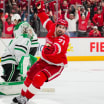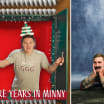Legendary hockey reporter Stan Fischler writes a weekly scrapbook for NHL.com. Fischler, known as "The Hockey Maven," shares his humor and insight with readers each Wednesday.
With the 2020 Stanley Cup Playoffs about to begin in unusual circumstances, Stan recounts perhaps the most improbable Stanley Cup challenge in history. It happened during Canada's Klondike gold rush in the 1890s and early 1900s. A gold-mining team called the Dawson City Nuggets represented the Klondike. Their trip from Dawson City to Ottawa was as difficult as their attempt to defeat the defending champion Ottawa Silver Seven.
Dawson City made improbable Stanley Cup challenge in 1905
Team from Yukon defied odds, travel problems before losing to Ottawa
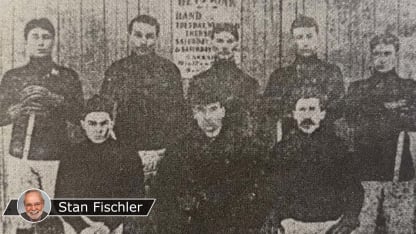
By
Stan Fischler
Special to NHL.com
Go way, way back in Stanley Cup history and you'll find the story of the most unlikely challenge since the Cup was first awarded in 1893.
Things were different then. Long before the Stanley Cup came under NHL control in 1926, it was possible for a team from just about any city or town in Canada to challenge for the trophy. That's because Lord Stanley of Preston originally donated the trophy as a challenge cup "to be held from year to year by the champion hockey club of the Dominion." Hence, the Stanley Cup.
But it's doubtful his Lordship could have envisioned that a team from a town called Dawson City in the Klondike mining region of Canada's Yukon Territory would ever complete for the Cup. However, in January 1905, the Dawson City Nuggets issued a challenge to the defending champion Ottawa Silver Seven -- but before getting the chance to compete, the Nuggets were challenged by the longest road trip in hockey annals, more than 4,000 miles from Dawson to Ottawa. To reach their destination the Nuggets had to travel by bicycle, dog sled, dingy railroad coach, boat and, finally, a fancy transcontinental train.
A gold rush in the late 1890s had turned Dawson City into a boom town that was oozing with sugar daddies looking for ventures for their growing gold surpluses. One of them was a local entrepreneur named Joseph Boyle, who cheered for the Dawson City Nuggets. The team was comprised of players from the four-team senior league in Dawson City who had visions of the Stanley Cup dancing in their heads.
"As in their dreams of monetary fortune, they decided to think big when it came to hockey," Dick Beddoes wrote in his book "Greatest Hockey Stories." "They figured 'Why not challenge the reigning team for The Stanley Cup?'"
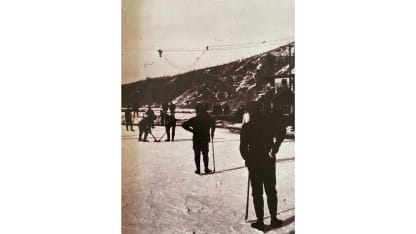
Boyle financed the trip. However, the Nuggets soon discovered that not only was getting there not half the fun; it was no fun at all.
For starters, they were pitted against the weather; it was 20 degrees below zero. But enthusiasm triumphed as Dawson City's faithful cheered their heroes, many of whom left via dogsled on Dec. 18, 1904. The remainder started the next day, riding bicycles.
"The Nuggets -- some running behind dog teams -- waved to the crowds lining the route as they made their way to Skagway," Beddoes wrote.
They had to travel 331 miles to Whitehorse before boarding a local train to Skagway, Alaska, the only seaway exit from the Yukon.
On the first dogsled day out of Dawson City, the Nuggets covered 46 miles; on the second, they went 41. By then the harsh weather had taken its toll. "On the third day," the Ottawa Citizen reported, "some of the Nuggets were suffering with blistered feet. To proceed they had to remove their boots during the mush."
The slow trip meant that the team missed its boat at Skagway by two hours. They were marooned there for five days before another boat was available.
"We had one practice while we stuck around Skagway," one of the Nuggets said. "It was a rink 40 feet by 50, half of it covered with sand, which dulled our skates."
Eventually, a battered scow called the "Dolphin," showed up at the Skagway dock for the voyage; the boat had to dock in Seattle because Vancouver, its intended destination, was fogged in. From there they took a train 200 miles to Vancouver for the Canadian Pacific mainliner to Ottawa.
Much as the players wanted to exercise, the best they could do on the CP Limited was the smoking room with a floor eight feet square.
"Skipping was our principal exercise," said one of the Nuggets.
The lineup was a mish-mash of characters led by George "Sureshot" Kennedy. Jim Johnstone, a defenseman, was the heavy checker while the goalie was Albert Forrest, a 17-year-old from Trois Rivieres, Quebec, who's still the youngest player in Stanley Cup history.
Awaiting them in Canada's capital was the best team in North America, the Ottawa Silver Seven. Sprinkled with stars such as Frank McGee and Harry Westwick, the home club was aiming for its third straight Cup. Yet word from the Yukon had an accent on the positive. The local newspaper reflected confidence about the Nuggets' chances for hockey immortality.
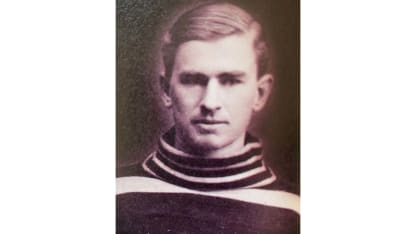
"Everywhere in Dawson," the Dawson City Daily News wrote, "the hope is expressed that the Yukoners will land the Cup and bring it to Klondike and keep it here forever."
The Nuggets were greeted by a familiar hometown face when they checked into Ottawa's Russell Hotel. Wealthy Yukon mining magnate J.A. Acklin was doing business in Ottawa, but nothing was more important to him than his favorite hockey team. Once the club had unpacked, Acklin delivered a dollar-coated speech:
"If you boys succeed in defeating Ottawa," he said, "I will make you a present of $1,000. We all admire the grit of the boys coming out after the silverware."
Acklin's offer provided some momentary balm for the exhausted Nuggets. Then came the bad news. Having arrived on Jan. 11, the Nuggets wanted a few days to unwind and practice. The Nuggets pleaded with the Silver Seven to delay the opening game, scheduled for Jan. 13, at least by one day. Though the home team was otherwise hospitable, the date stayed the same.
In their book, "Ultimate Hockey," authors Glenn Weir, Jeff Chapman and Travis Weir noted that the Nuggets enjoyed a spirited workout in their lone scrimmage before Game 1.
"Despite being a little worse for wear, the boys were in decent shape," they wrote. "Even if they lacked grace, they took to their first practice in weeks with spirit."
After checking out the Nuggets, a Montreal Gazette reporter noted, "They are one and all fine big fellows, able to rough it up with the best of them -- fast skaters and good stickhandlers."
Meanwhile, owners of Dey's Gladstone Avenue Rink hardly could handle ticket demands for the Cup opener. The 2,500 seats were gobbled up by "surging crowds" and "hysterical" fans, as the Ottawa Journal described them. If nothing else, the Nuggets won plaudits for their fashion plate outfits, described by the Journal as "gaudy uniforms of black and gold stripes with white knickers and striped stockings."
But once the puck was dropped for Game 1, it became no contest. The game, according to Beddoes, "was as one-sided as a firing squad."
Ottawa lived up to its reputation in a 9-2 victory. "The visitors were clearly outclassed," commented the Journal."It is true they hardly had time to get in shape, but the form they showed was most mediocre."
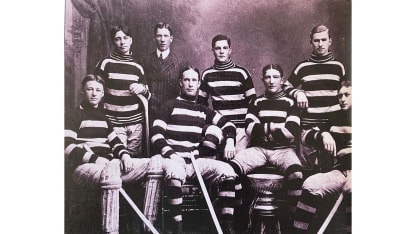
Still the optimist, Boyle promised that the between-games respite would energize his team.
"The assurance is given that the interval of Saturday and Sunday will give the boys the needed opportunity to stretch their legs," he said. "Monday's game will be a different story."
Different, maybe -- but far worse. On Jan. 16, 1905, Ottawa's all-game blitz ended in a 23-2 victory, with McGee scoring 14 goals, including eight in a row at one point.
Would a little more rest have helped? After their Cup embarrassment, the Nuggets played a 23-game run of exhibitions on the way home, compiling a respectable record of 13-9 with one tie before returning to the Yukon -- minus the Cup but with their honor intact.












